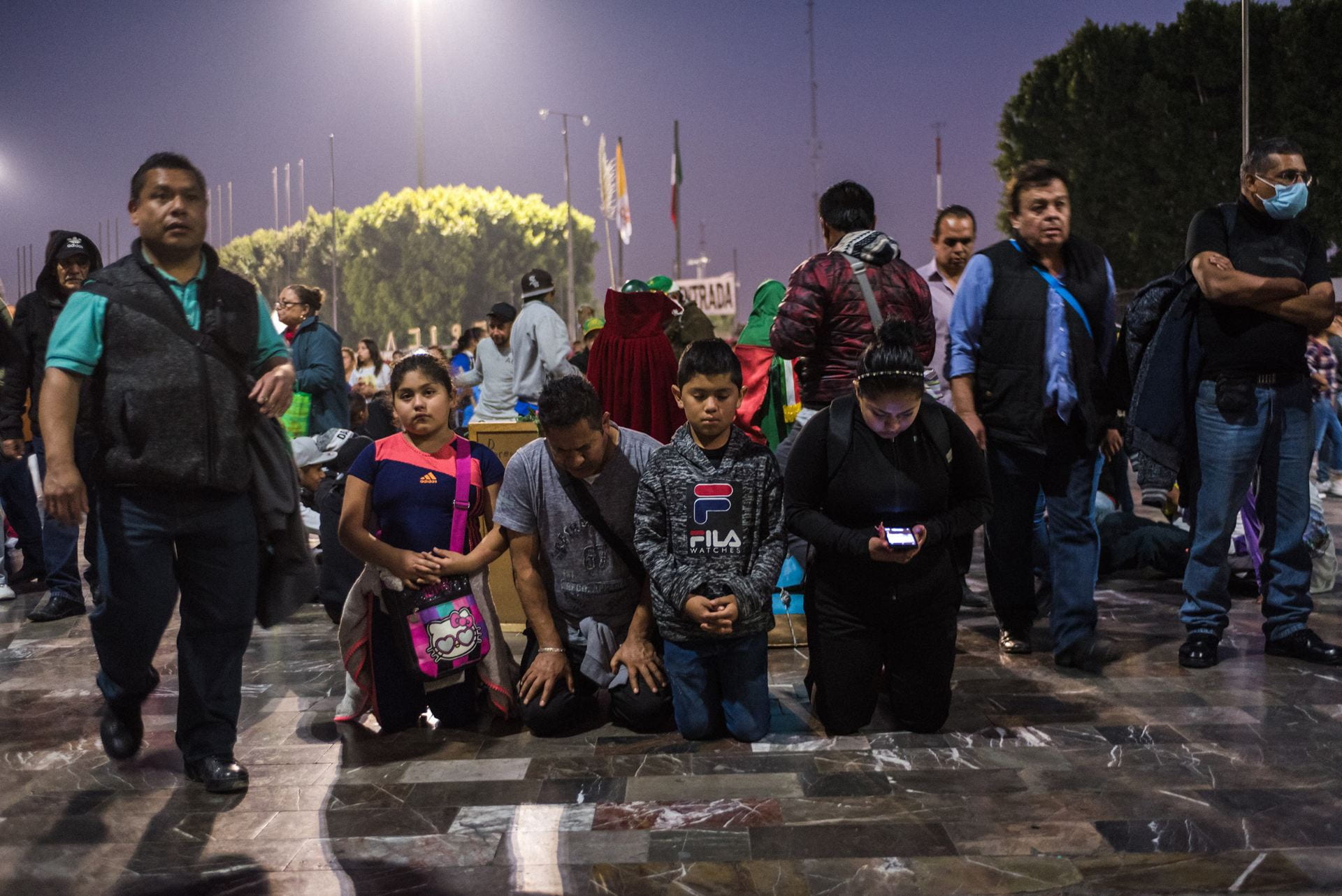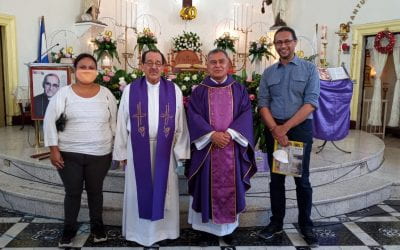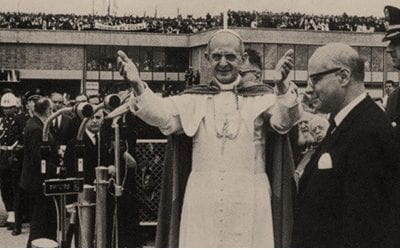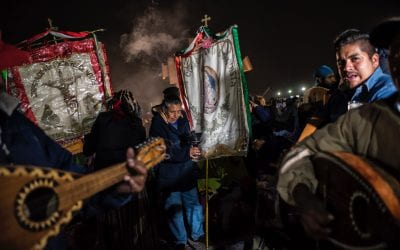The Pilgrimage to Guadalupe: Sacred Renewal in Mexico City
A Photoessay by Ryan Christopher Jones
Mother of gods and men, of stars and ants, of maize and agave, Tonantzin-Guadalupe was the imaginary compensation of the Indians for the state of orphanage to which the Conquest had reduced them…The Feast Day of Guadalupe, December 12, is still the feast day par excellence, the central date of the emotional calendar of the Mexican people.
-Octavio Paz, “The Flight of Quetzalcóatl and the Quest for Legitimacy”
Along the Calzada de Guadalupe in Mexico City, I walked shoulder to shoulder with a growing swarm of pilgrims. They moved briskly and flocked in passage, with printed images of the Virgen de Guadalupe on their arms or backs. They carried sacred bundles from their villages and homes—items transported for spiritual regeneration—statues, paintings, banners, candles, crosses and flags. Some trekked hundreds of miles, their backpacks overflowing with a week’s worth of clothes and blankets. A few dropped to their knees, skin to stone, as they began the slow and sacrificial crawl to the Basilica of Guadalupe, where they would trade physical pain for spiritual rewards. Whether walking or crawling, the steady procession fixed their eyes toward Tepeyac Hill a mile away: a sacred mountain, an imminent renewal.
It was the annual feast of the Virgen de Guadalupe, a centuries-old Catholic pilgrimage to celebrate the miracle on Tepeyac Hill. According to Catholic tradition, in 1531 the mother of Christ presented herself on the hill to a Nahua villager named Juan Diego. She left him a cloak imprinted with an image of herself—a glowing, brown-skinned goddess robed with stars. In the following centuries the image was used to evangelize and convert the indigenous Nahua in the Valley of Mexico, who were skeptical of this newfound Christianity. As a product of Spanish colonialism and forced conversion, the image is not without its difficult histories, but its long- lasting cultural importance cannot be overstated. The image, 500 years later, has become a diverse and omnipresent symbol for the continuing tenacity of Mexico and its people.
Though it was my first time visiting the Basilica, the image of Guadalupe was a fixture of my upbringing. Since I was a child, the brown-skinned goddess has been burned into my imagination as a symbol of family, faith and heritage. My grandmother Beatrice was born and raised in Mexico and her devotion to the Virgen has been a lifelong kinship, one she has gifted to her descendants of four generations. The walls of my grandparents’ small home in my hometown of Fresno, California, are covered floor-to-ceiling with pictures and figures of the Virgen that overlap with pictures of us, her family. Their home introduced me to the many symbols, traditions, and myths of Mexico, and also to the ancestral power of sacred imagery. It’s why my first trip to the Basilica felt like home. I wandered its grounds with a sense of familiarity and belonging, because in these these pilgrim’s faces I saw the devotion of my grandmother. In their statues and pictures, I saw her walls bursting with the same images.
These photos are from a trip I made in December 2018 to document the Guadalupe pilgrimage in Mexico City for The New York Times. I am a full-time photojournalist and ALB candidate in Anthropology at the Harvard Extension School. In Fall 2018, I enrolled in Professor Davíd Carrasco’s class, “Moctezuma’s Mexico Then and Now: The Deep History, Triumphs, and Transformations of the Aztecs and their Descendants.” Carrasco’s class was a brilliant meditation on nearly a thousand years of Mexican history and it intensified a quest to make sense of my own Mexican-American ancestry and identity. I am fortunate to work in a field that allows my personal and academic interests to intersect with my professional ones. This assignment to Mexico City was a compelling example of these intersections.
The 2020 Guadalupe festivities were cancelled due to Covid-19. For the first time in nearly a century, the pilgrimage was not held. The Basilica’s celebrations were moved online, creating a virtual pilgrimage. In a pandemic world of muted socialization and increasing isolation, my photos from 2018 now feel surreal. The throngs of maskless crowds and extravagant indoor celebrations read as a different world, and in many ways it is a different world. Despite the unwelcome changes to the ways we live, worship and socialize, one thing can be for certain: la Virgen de Guadalupe will persist, as she has for many centuries. Mexico has seen plague and suffering before and la Virgen has been there to provide solace and healing. Mourners have cried over the deaths of loved ones and la Virgen has wept with them. The pandemic has altered the future of Mexico and the rest of the world, and just as in the centuries that precede us, Mexicans across the globe will pull la Virgen into yet another new social reality.

Jesus Vicuña made the 80-mile trek by foot from Puebla, and he made a promise with the Virgin of Guadalupe: if she healed his sick mother, he would walk part of the journey on his knees as a sacrifice and testament to his thankfulness. He suffered the last half-mile along the Calzada on his knees, his eyes filled with tears but narrowly focused on the Basilica. “If I can get through this, I can get through anything,” he said with a large painting of Guadalupe affixed to his backpack. He collapsed onto the stone floor of the Basilica of Guadalupe, panting and groaning, but content he fulfilled his promise to the Virgin. He soon disappeared into the sea of people inside the Basilica as they all converged into a small hallway, hoping to grab a glimpse of Juan Diego’s miraculous cloak.
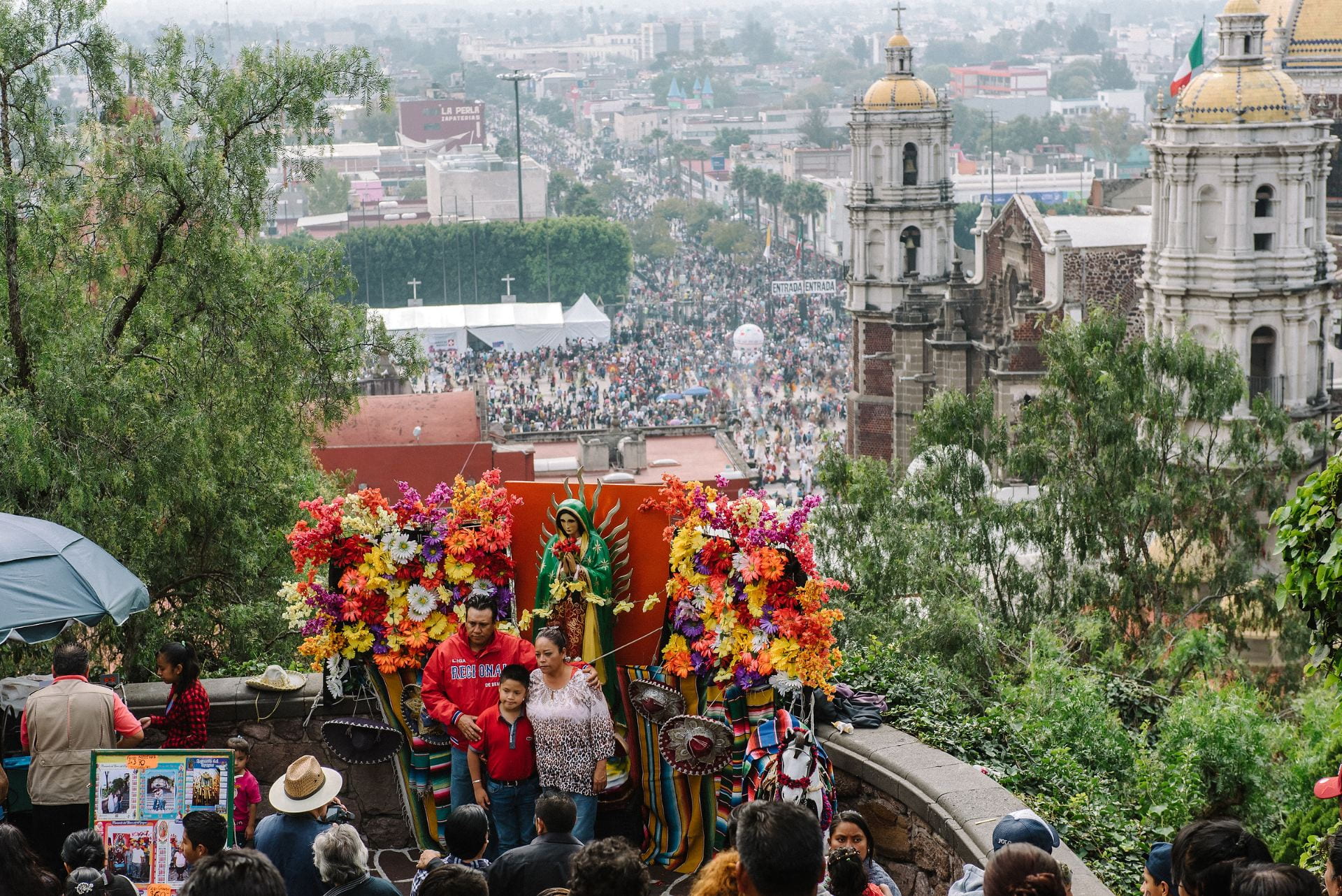
Once inside the Basilica grounds visitors make the long hike up to Tepeyac Hill, where families proudly posed for pictures and vendors sold objects of devotion. I stood near the top of the sacred mountain and saw masses of people somehow occupying every possible area, and I felt the true magnitude of both the pilgrimage and Mexico City. Historically called the Valley of Mexico, only from a high vantage point can someone really make sense of the grandeur of both time and space in North America’s densest urban area.
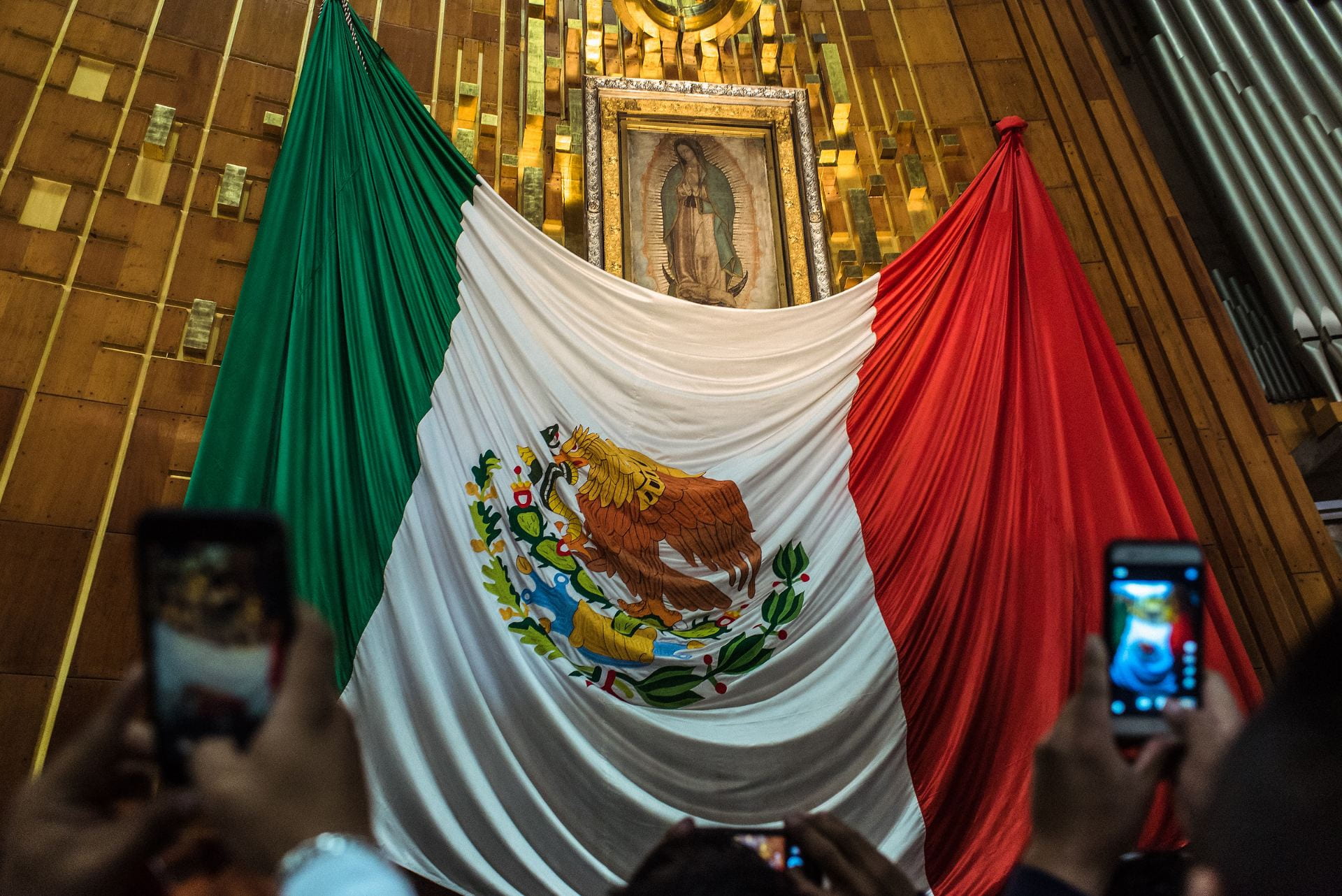
Behind the altar at the Basilica of Guadalupe, visitors photograph the space where a massive Mexican flag hangs underneath the original tilma of Guadalupe from 1531. According to legend, the Mexica/Aztecs were told by their sun god, Huitzilopochtli, to migrate until they spotted an eagle devouring a serpent while perched atop a cactus. They wandered for 200 years until they saw that scene at Mexico-Tenochtitlan (Mexico City) and it is where they built their empire. Seen as symbols of home, renewal and origin, the Mexican coat of arms and the image of la Virgen de Guadalupe both share the same purpose: to celebrate and honor the creation of the Mexican people.
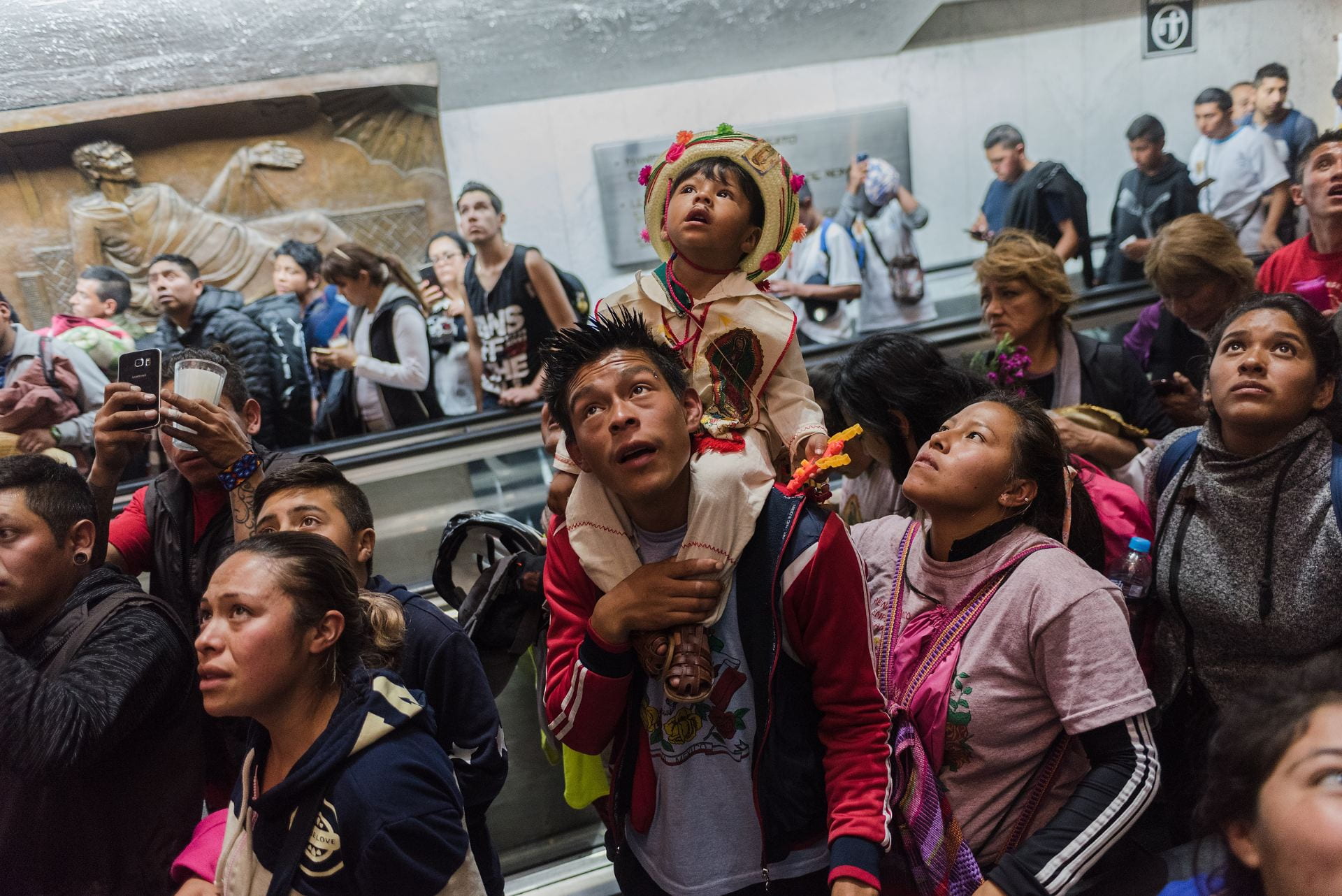
Secured to his father’s shoulders, a young boy dressed as Juan Diego looks up in astonishment to the tilma of Guadalupe. Along the electric walkway, visitors have limited time to take in the sacred sight, but their collective, focused gaze is one of reverence and devotion. Though many looked up with their mouths open, few managed to speak.
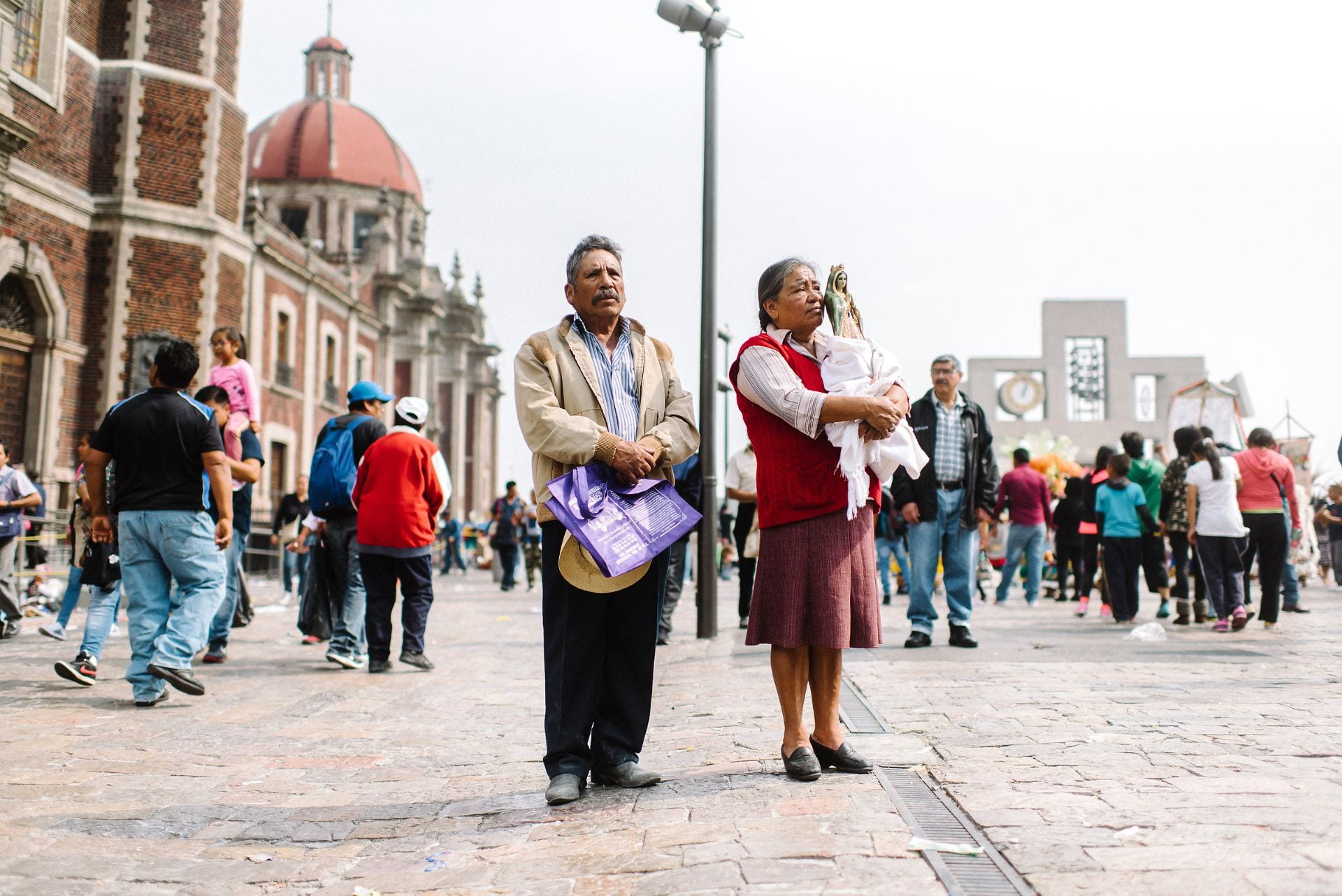
Agustin María, and his wife, Lucía María, take pause during the festivities to look towards the Basilica. During the week of festivities in December 2018, an estimated nine million people made the pilgrimage to the Basilica, which is one of the world’s largest religious pilgrimages.
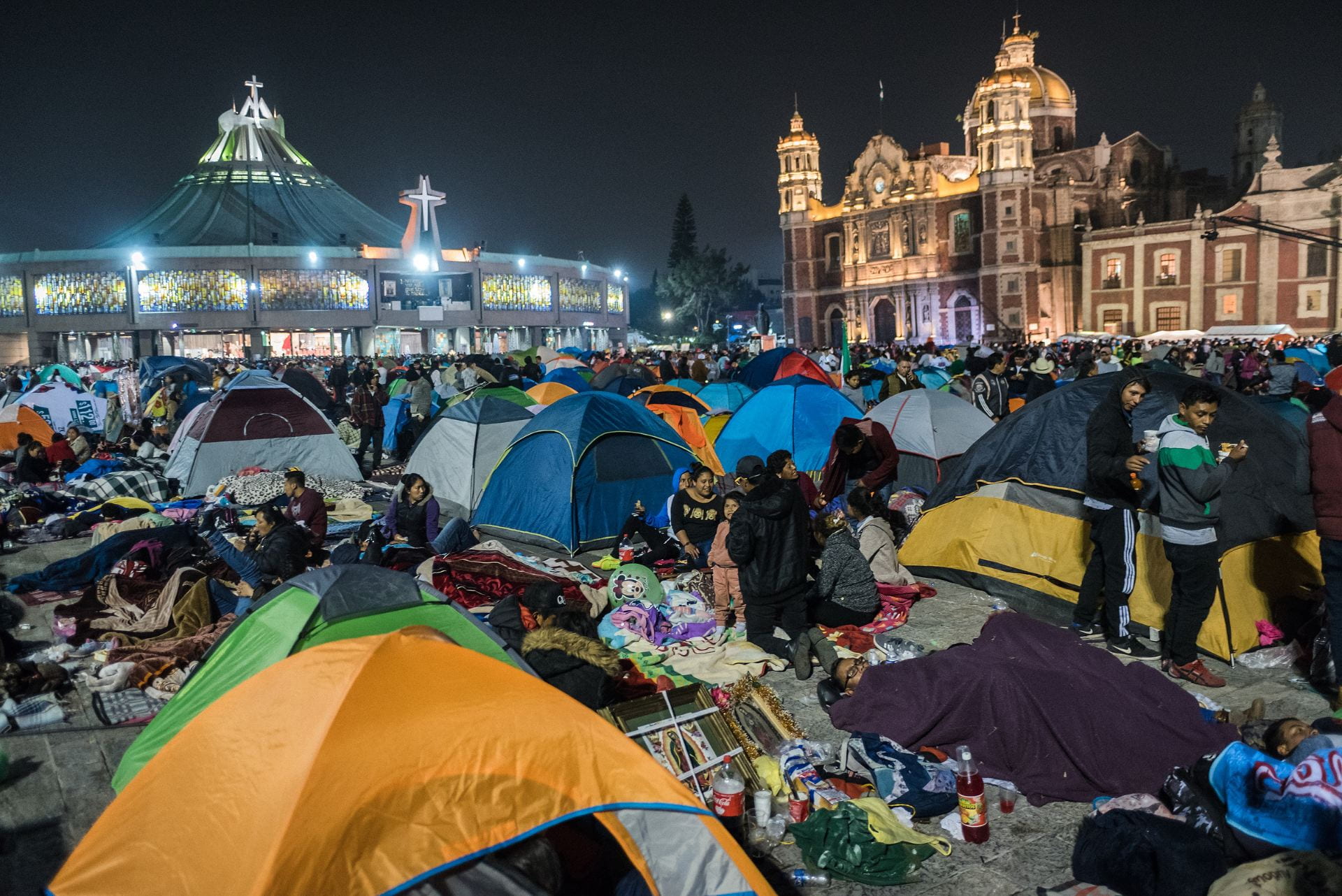
On the eve of the feast’s main festivities, visitors set up camp in the Basilica’s courtyard while the celebrations continue through following days and nights. The scene radiates with energy as the pilgrims sing, dance, congregate, pray and be present in the holiest of Mexican sites on the holiest of Mexican days.

Aztec dancers perform ancient dances and rituals in the Basilica’s main courtyard, burning sage and beating drums while invoking Aztec gods of Tonanztin and Huitzilopochtli. The festivities honoring Guadalupe are simultaneously indigenous and colonial, and in many ways they represent the religious complexity that existed when Mexico was an infant country trying to make sense of its values and beliefs under colonial rule.
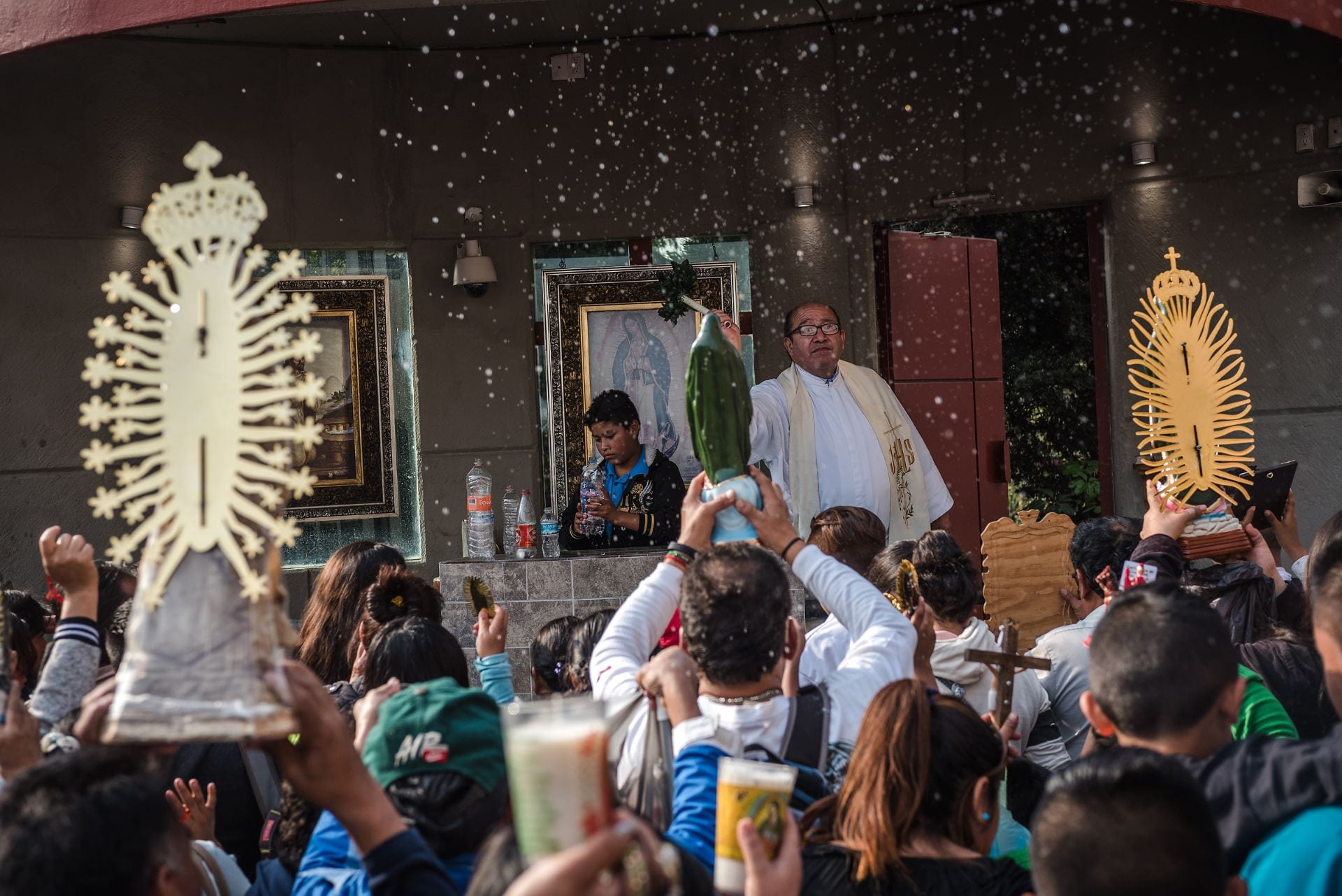
A crowd gathers as a priest splashes devotional objects with holy water. In Catholic tradition, holy water applied to an object is a transfer of spiritual energy from the place it was received. In this respect, the visitors take a piece of the sacred from the Basilica back to their homes, where it will live until the next blessing or pilgrimage renews its spiritual power. For as many people were at the Basilica during these days, twice as many devotional objects came with them.
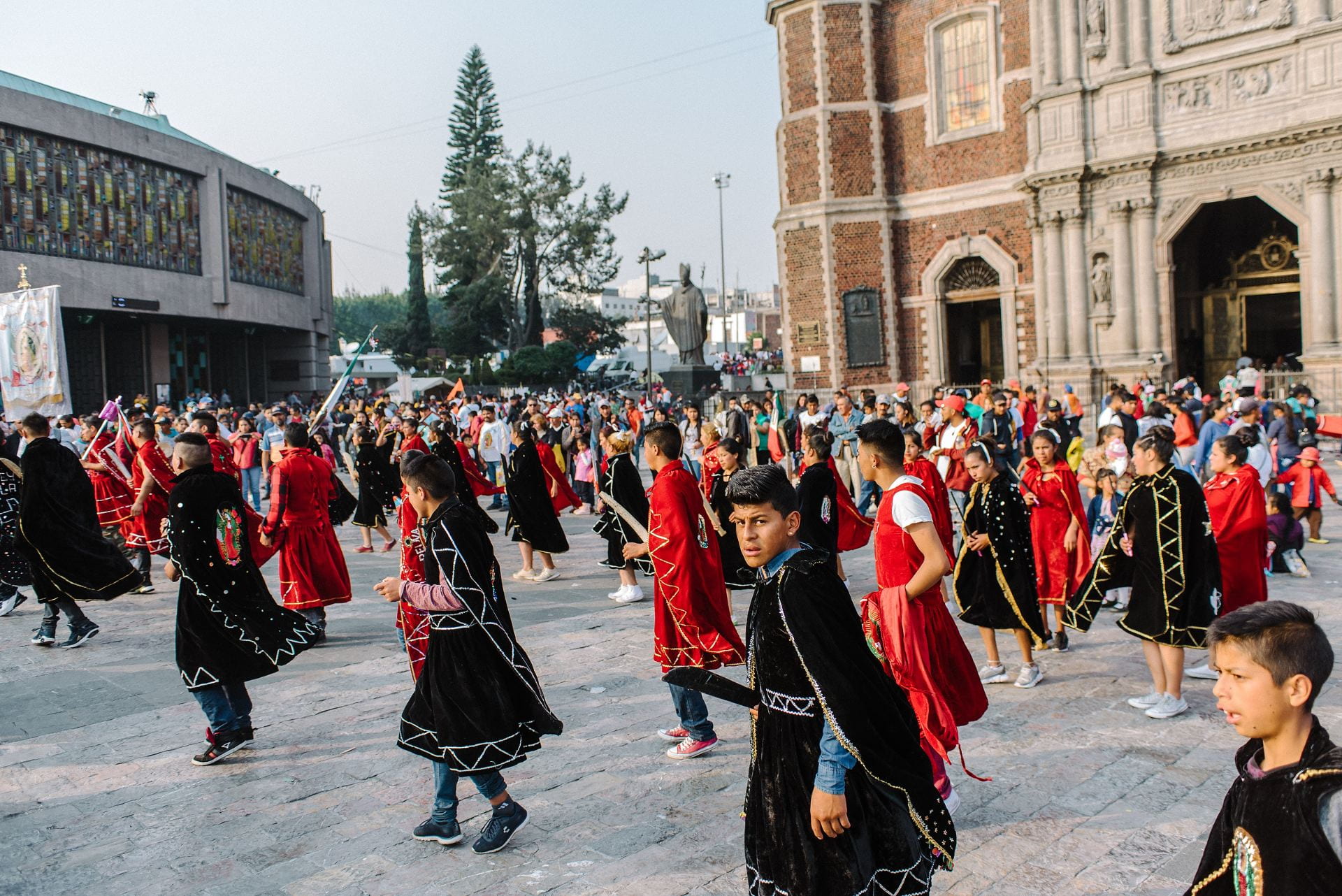
In the same courtyard, a large group of young people dressed in traditional Spanish clothing acted out their own cultural dances. Wearing distinctly European garb they moved through the space that was just occupied by the Aztec dancers—a jarring parallel to the Conquest itself—and in the same sacred space where a distinctly Mexican Catholicism took root. La Virgen became a symbol of merging cultures, and in this respect, she was neither fully indigenous nor fully Catholic, but exactly both — much like Mexico itself. These two groups of dancers were a striking reminder that indigenous and Spanish cultures live, breath, and worship in modern Mexico side-by-side, a mestizo nation of two civilizations.
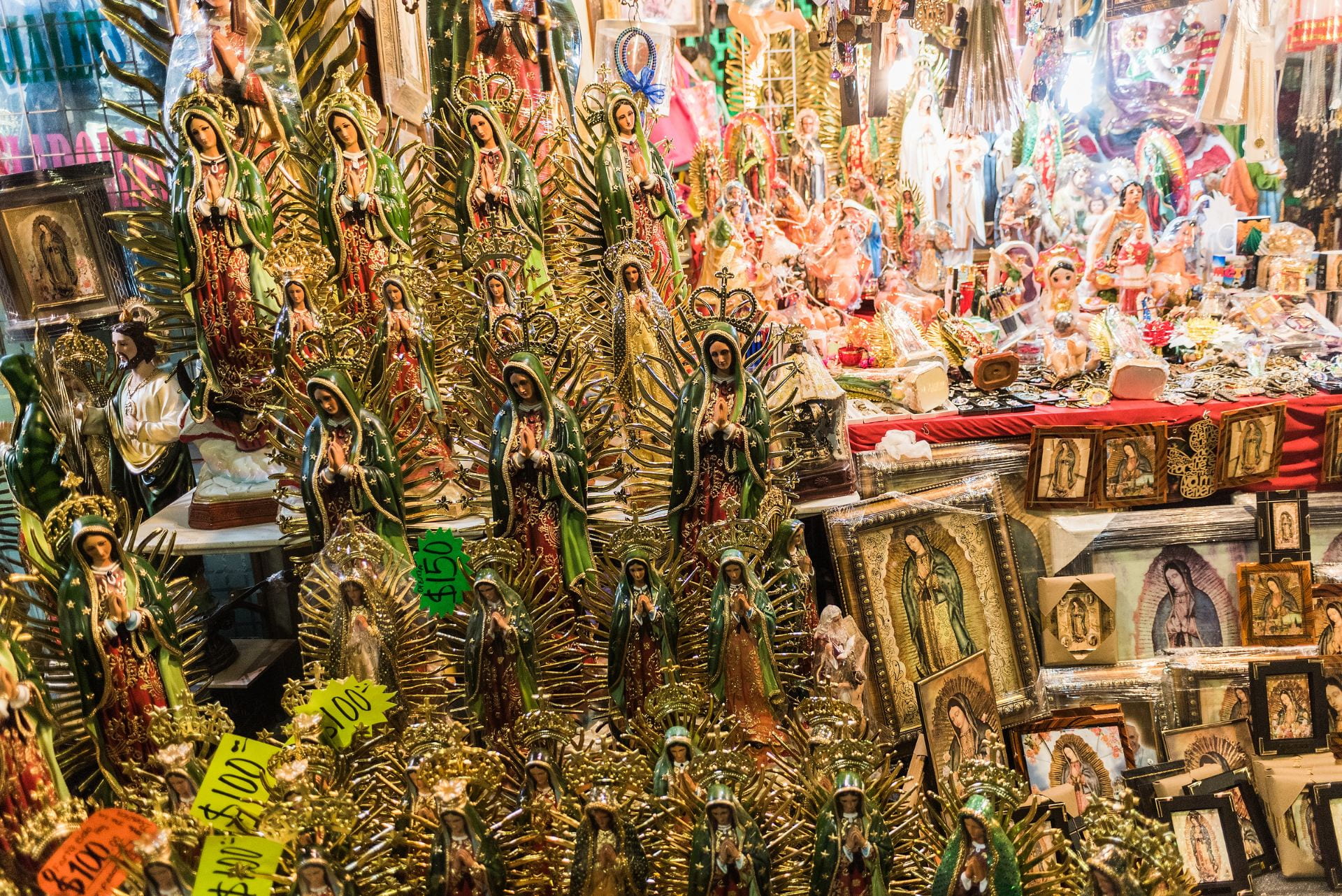
Devotional paintings and statues of the Virgen de Guadalupe are sold at a shop just outside the Basilica of Guadalupe. Among the many shops that line the streets are countless rooms filled ceiling high with devotional objects honoring la Virgen de Guadalupe. From a destination of religious pilgrimage, these objects often blur the line between tourist souvenir and meaningful religious artifact.
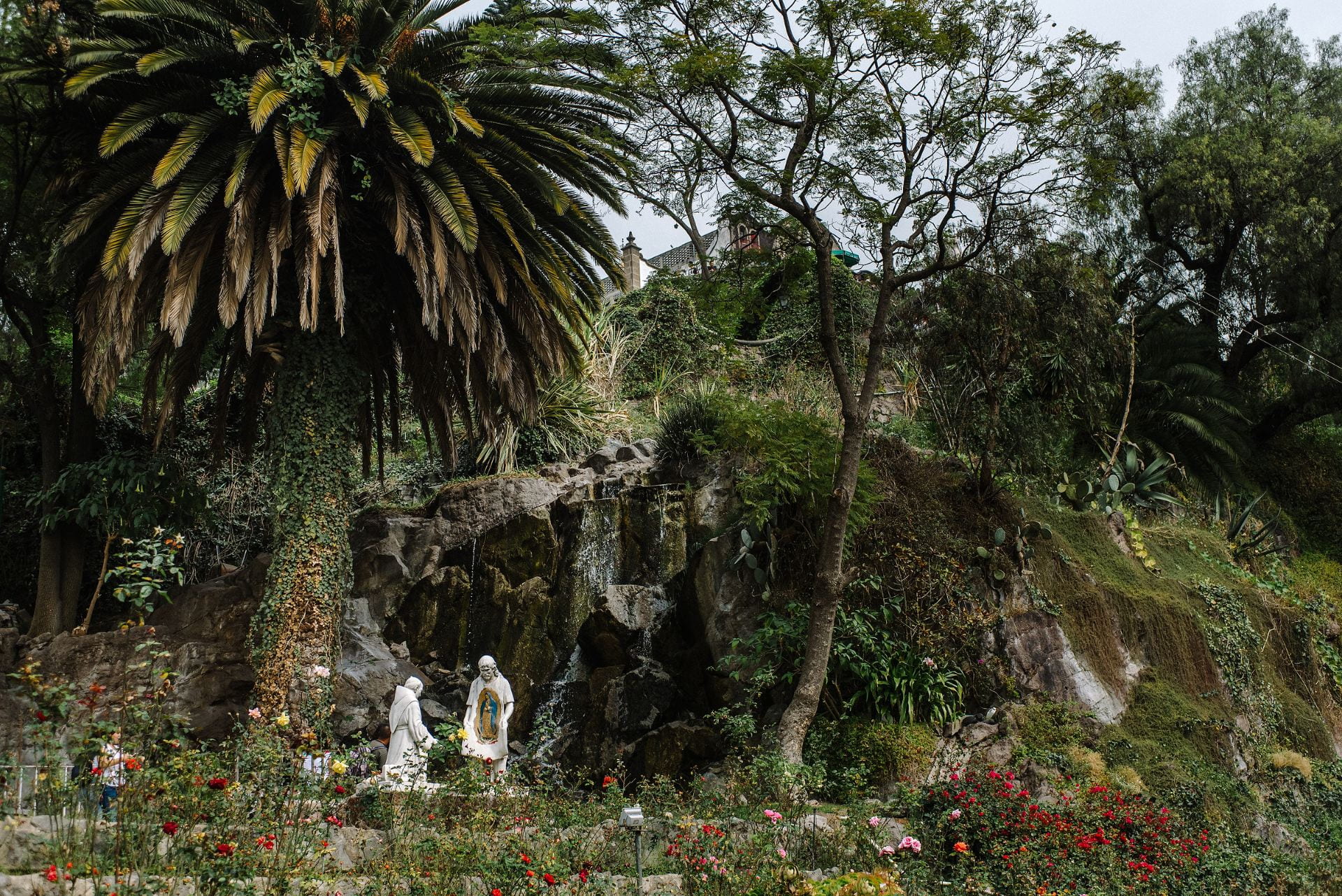
A statue of St. Juan Diego and Fray Juan de Zum‡arraga on Tepeyac Hill at the Basilica of Guadalupe. Zumarraga was the 16th century Franciscan priest who first received the news from Juan Diego that the Virgen had presented herself on Tepeyac Hill.
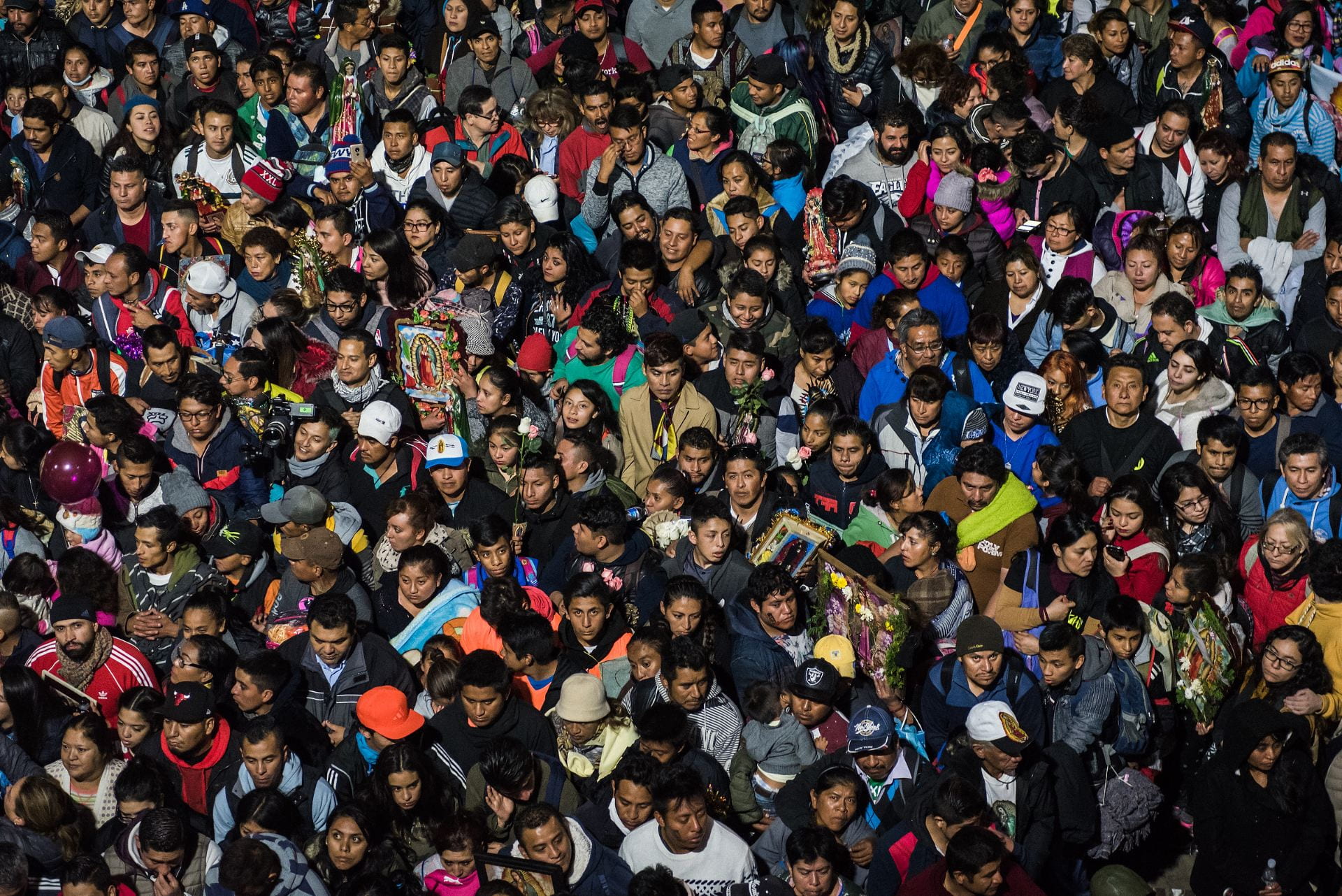
A large crowd gathers in the basilica’s courtyard the night before of the feast day of Guadalupe officially begins. People look up to the towering basilica, waiting their turn to enter the church as catch a glimpse of Juan Diego’s tilma.
As the clock crept towards midnight approaching December 12, I stood on the balcony of the new Basilica of Guadalupe and looked down into the main plaza. This historical space overflowed with people from all over Mexico to celebrate the country that it has become because of the Virgin. At the stroke of midnight a bell rung, and the crowd started to sing in unison, and the traditional mañanitas birthday song filled the courtyard with thousands of voices:
How pretty is the morning In which I come to greet you.
We all came with pleasure and joy to congratulate you. On the day you were born
All the flowers were born.
At the baptismal font The nightingales sang. It is starting to be dawn,
The day has given us light.
Get up in the morning,
Look at what you’ve already dawned.
—(This translation of Las Mañanitas) is by Miguel Govea and la familia Piña-Govea)
Winter 2021, Volume XX, Number 2
Ryan Christopher Jones is a Mexican-American photojournalist originally from California’s Central Valley and currently living in New York City. In addition to working on stories of immigration, labor and identity, Ryan is a fierce advocate of compassionate photojournalism and he has written on this theme in two essays for the New York Times, “How Photography Exploits the Vulnerable” and “The Deja Vu of Mass Shootings.” Ryan is also an ALB candidate in Anthropology at Harvard Extension School.
Ryan’s portfolio can be seen at ryanchristopherjones.com
Related Articles
El Salvador, Back in the Day
The glory days are long gone. They began in the 70s. Extraordinary grassroots pastoral work, accompanied by a then-new school of thought known as “liberation
Christianity between Religious Transformations
English + Español
In the second half of the 20th century, Latin America was surprised by religious changes that not only were transforming the religious panorama, but also influencing both society and politics. Beginning in the 1950’s, some in the Catholic Church—not just priests and…
The Mexican Angels in the Attic
Years before I met the Mexican angels in that Chicago attic, my abuela Carlota Carranza Carrasco told me about religion. Carlota was born in Batopilas at the bottom of the Cañon del Cobre in 1896 and crossed the border into El Paso to escape the chaos of the Mexican Revolution in 1912…

